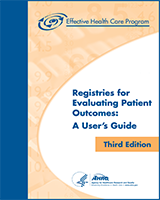From: 20, Rare Disease Registries

NCBI Bookshelf. A service of the National Library of Medicine, National Institutes of Health.
| Description | The Digital Ulcers Outcome (DUO) Registry collects data on patients with systemic sclerosis in an effort to describe digital ulcers disease history, clinical and patient-reported functional assessment status and treatment pattern at the time of enrollment, disease course, and patient management during followup. For patients treated with bosentan, data are collected on physician adherence to labeling guidelines and safety events. |
|---|---|
| Sponsor | Actelion Pharmaceuticals |
| Year Started | 2008 |
| Year Ended | Ongoing |
| No. of Sites | More than 350 |
| No. of Patients | 3,609 |
Systemic sclerosis (scleroderma) is a rare disease affecting less than 2 in 10,000 persons worldwide. Digital ulcers affect nearly 30 percent of patients with this disease, resulting in substantial morbidity such as gangrene and amputation. Despite the severity of digital ulcers, very little is known about this complication, due to the rarity of the underlying condition. To improve understanding of this condition, data are needed from specialized participating scleroderma centers (sites).
The DUO Registry was mandated by the European Medicines Agency (EMA) as a post-approval licensing requirement for the expanded indication of bosentan to treat digital ulcers. The registry, which operates in 18 European countries, is observational and voluntary in nature, and participating sites are reimbursed solely for data entry time. After 4 years of operation, motivation of the participating physicians started to stagnate, and the sponsor observed a decrease in followup data entry. Because the registry was mandated by the EMA and because of the paucity of outcomes data available about digital ulcers, the sponsor sought to increase participation and in particular, increase the collection of followup data.
The sponsor identified academic and professional interest in the registry's findings around digital ulcer management as one of the primary motivators for investigators to participate in the study. To respond to this interest, the sponsor implemented new efforts to engage investigators and regularly inform them of the study's progress. Efforts included the use of newsletters to provide enrollment updates and tips on using the electronic data capture system, presentation of abstracts in scientific congresses, and distribution of letters from the registry steering committee to the investigators encouraging them to enter followup data. An in-person investigator meeting was held where the registry's scientific committee discussed registry findings with the investigators. The sponsor also established a process for investigators to suggest publication ideas and determined that all publications of registry data would include the phrase “and DUO Registry investigators” in the author byline.
From 2011 to 2012, the proportion of patients having at least one followup visit increased from 63 percent to 73 percent, and the mean number of visits per patient increased from 1.7 to 2.6. The registry has now enrolled more than 3,600 patients.
The steering committee and registry investigators published the first original article on registry data in January 2012, reporting on data from 2,439 patients and confirming the disease burden of digital ulcers in systemic sclerosis patients. The sponsor had received feedback that the shared authorship is valuable to some investigators and a major motivating factor for their participation in the registry.
A poster highlighting the current variation in treatment of digital ulcers across Europe and stressing the need for a concentrated approach to establish disease management practices was presented at the European League Against Rheumatism 2012 Annual Congress.
Site engagement is particularly important in rare disease registries, because of the limited number of patients. Consistent communication highlighting study objectives and achievements, visibility at scientific meetings, and sharing authorship or acknowledgement on publications can bolster investigators' motivation.
Denton CP, Krieg T, Guillevain L, et al. Demographic, clinical and antibody characteristics of patients with digital ulcers in systemlic sclerosis: data from the DUO registry. 2012 Ann Rheum Dis;71:718–21 [PMC free article: PMC3329234] [PubMed: 22247218].
Matucci-Cerinic M, Guillevin L, Denton CP, et al. Management of digital ulcer disease varies across Europe: findings from the DUO registry; Poster presented at The European League Against Rheumatism 2012 Annual Congress; Berlin, Germany. 6-9 June 2012; [August 8, 2012]. https://www.duo-registry.com/ACT7001/(S(pgk5tifal0a3yw45f3wrde55))/DUO/documents/EULAR%202012%20DUO%20poster%2029052012.pdf..
From: 20, Rare Disease Registries

NCBI Bookshelf. A service of the National Library of Medicine, National Institutes of Health.